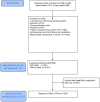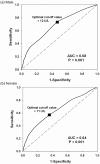Predictive Value of Serum Gamma-glutamyltranspeptidase for Future Cardiometabolic Dysregulation in Adolescents- a 10-year longitudinal study
- PMID: 28851958
- PMCID: PMC5574888
- DOI: 10.1038/s41598-017-09719-8
Predictive Value of Serum Gamma-glutamyltranspeptidase for Future Cardiometabolic Dysregulation in Adolescents- a 10-year longitudinal study
Erratum in
-
Author Correction: Predictive Value of Serum Gamma-glutamyltranspeptidase for Future Cardiometabolic Dysregulation in Adolescents- a 10-year longitudinal study.Sci Rep. 2018 Nov 13;8(1):16934. doi: 10.1038/s41598-018-34497-2. Sci Rep. 2018. PMID: 30425254 Free PMC article.
Abstract
Serum gamma-glutamyltransferase (γ-GT) is implicated in the pathogenesis of atherosclerosis and metabolic syndrome (MetS) in adults. The relationships between γ-GT and cardiometabolic dysregulation remains unclear in adolescents. We enrolled 7,072 Taiwanese adolescents and followed them for a median of 6.8 years. The optimal cut-off values (CoVs) of baseline γ-GT to predict future MetS, hypertension (HTN), and type 2 diabetes (T2DM) were determined by receiving operating characteristic (ROC) curve. Using these CoVs, the participants were divided into normal- and high-level groups. Cox proportional hazard analysis was used to calculate hazard ratios (HRs) for the subjects with a high level of γ-GT for the risk of future cardiometabolic dysregulation. Serum γ-GT was significantly higher in the subjects with MetS than in those without MetS at baseline (p < 0.001). The optimal CoVs of γ-GT were 12 U/L for boys and 11 U/L for girls. In multivariate Cox regression analysis, a higher serum γ-GT level increased the risk of future MetS (HRs 1.98 and 2.85 for boys and girls, respectively, both p < 0.001), but not new onset HTN and T2DM. In conclusion, serum γ-GT levels not only demonstrated an excellent correlation with the presence of MetS and also in predicting future MetS in adolescents.
Conflict of interest statement
The authors declare that they have no competing interests.
Figures



Similar articles
-
The Role of Uric Acid for Predicting Future Metabolic Syndrome and Type 2 Diabetes in Older People.J Nutr Health Aging. 2017;21(3):329-335. doi: 10.1007/s12603-016-0749-3. J Nutr Health Aging. 2017. PMID: 28244574
-
Circulating nitric oxide metabolites and the risk of cardiometabolic outcomes: a prospective population-based study.Biomarkers. 2019 Jun;24(4):325-333. doi: 10.1080/1354750X.2019.1567816. Epub 2019 Feb 15. Biomarkers. 2019. PMID: 30624084
-
γ-glutamyl transpeptidase in men and alanine aminotransferase in women are the most suitable parameters among liver function tests for the prediction of metabolic syndrome in nonviral hepatitis and nonfatty liver in the elderly.Saudi J Gastroenterol. 2015 May-Jun;21(3):158-64. doi: 10.4103/1319-3767.157564. Saudi J Gastroenterol. 2015. PMID: 26021775 Free PMC article.
-
Association between Serum Calcium and Risk of Cardiometabolic Disease among Community-dwelling Adults in Taiwan.Sci Rep. 2020 Feb 21;10(1):3192. doi: 10.1038/s41598-020-60209-w. Sci Rep. 2020. PMID: 32081877 Free PMC article.
-
Serum γ-glutamyltransferase: independent predictor of risk of diabetes, hypertension, metabolic syndrome, and coronary disease.Obesity (Silver Spring). 2012 Apr;20(4):842-8. doi: 10.1038/oby.2011.136. Epub 2011 Jun 2. Obesity (Silver Spring). 2012. PMID: 21633402
Cited by
-
An exposome-wide association study on body mass index in adolescents using the National Health and Nutrition Examination Survey (NHANES) 2003-2004 and 2013-2014 data.Sci Rep. 2022 May 25;12(1):8856. doi: 10.1038/s41598-022-12459-z. Sci Rep. 2022. PMID: 35614137 Free PMC article.
-
Association Between Sex-Specific Serum Gamma-Glutamyltransferase and Incidence of Hypertension in a Chinese Population Without Metabolic Syndrome: A Prospective Observational Study.Front Cardiovasc Med. 2021 Apr 16;8:644044. doi: 10.3389/fcvm.2021.644044. eCollection 2021. Front Cardiovasc Med. 2021. PMID: 33937358 Free PMC article.
-
The Association Between Gamma-Glutamyl Transferase and Metabolic Syndrome and Its Components Among Adolescents Applying International Diabetes Federation (IDF) and Cook's Criteria.Endocrinol Diabetes Metab. 2025 Sep;8(5):e70074. doi: 10.1002/edm2.70074. Endocrinol Diabetes Metab. 2025. PMID: 40820390 Free PMC article.
References
-
- Freedman DS, Mei Z, Srinivasan SR, Berenson GS, Dietz WH. Cardiovascular risk factors and excess adiposity among overweight children and adolescents et al. Cardiovascular risk factors and excess adiposity among overweight children and adolescents: the Bogalusa Heart Study. J Pediatr. 2007;150:12–17.e2. doi: 10.1016/j.jpeds.2006.08.042. - DOI - PubMed
-
- Li C, Ford ES, Zhao G, Mokdad AH. Prevalence of pre-diabetes and its association with clustering of cardiometabolic risk factors and hyperinsulinemia among U.S. adolescents: National Health and Nutrition Examination Survey 2005–2006. Diabetes Care. 2009;32:342–347. doi: 10.2337/dc08-1128. - DOI - PMC - PubMed
Publication types
MeSH terms
Substances
LinkOut - more resources
Full Text Sources
Other Literature Sources
Medical
Molecular Biology Databases
Miscellaneous

